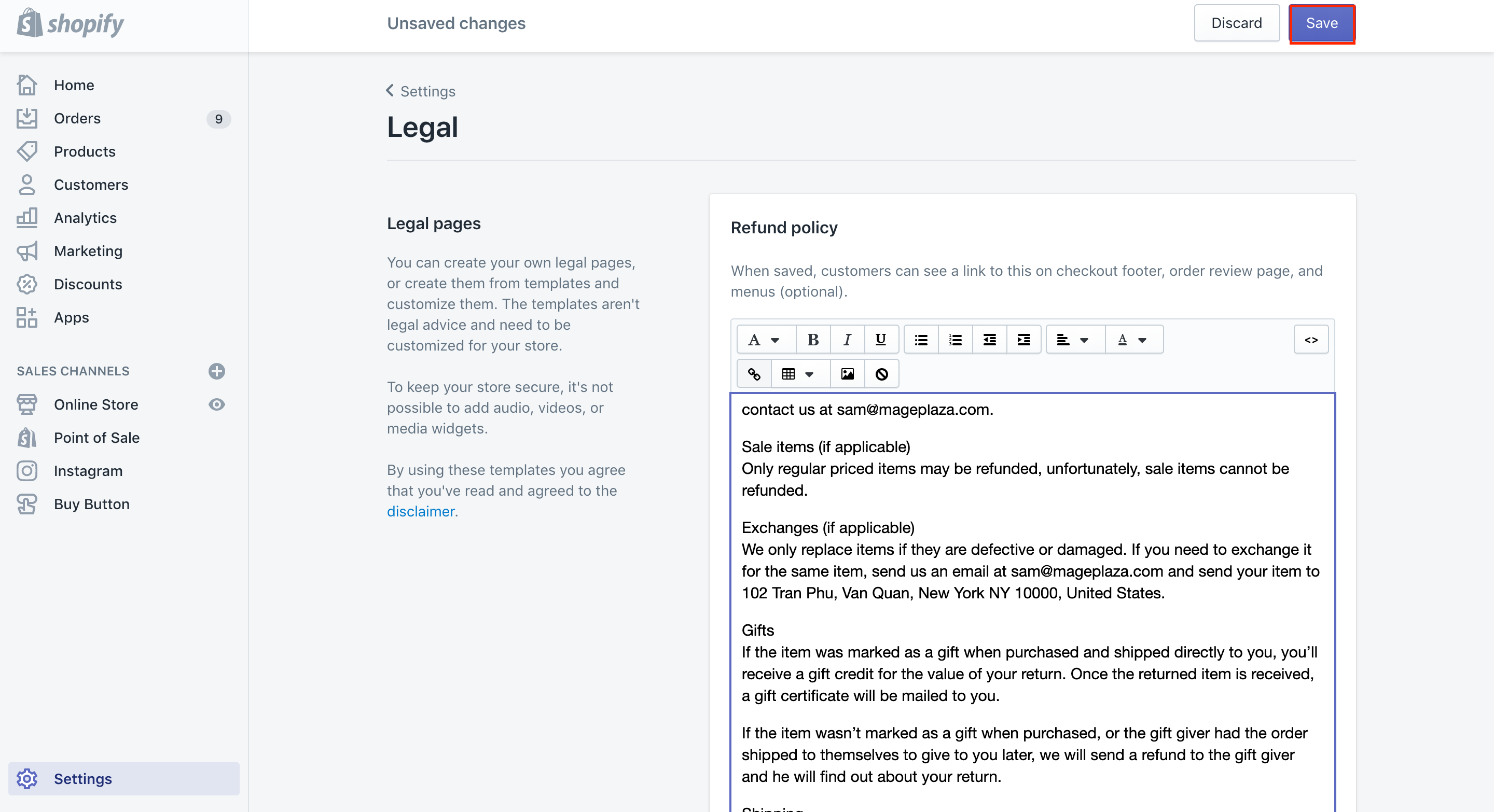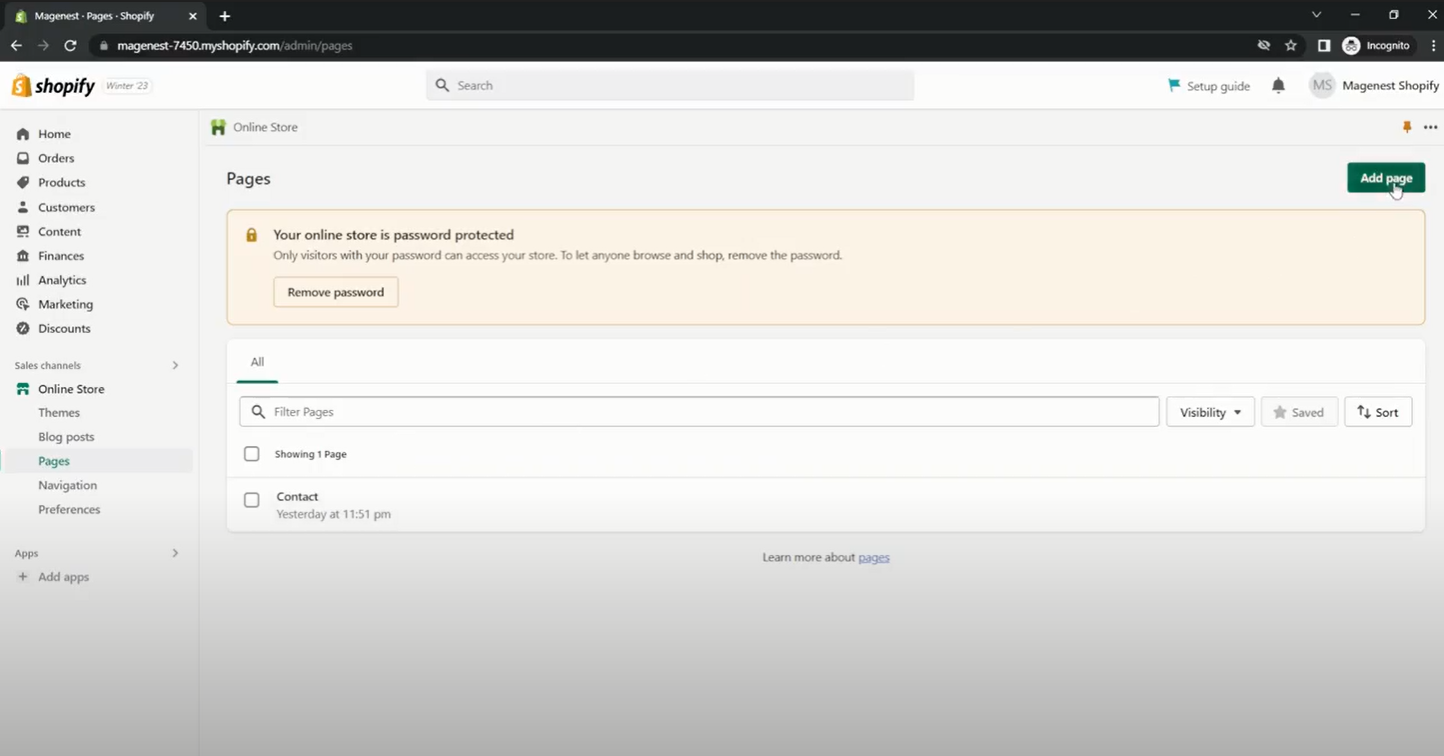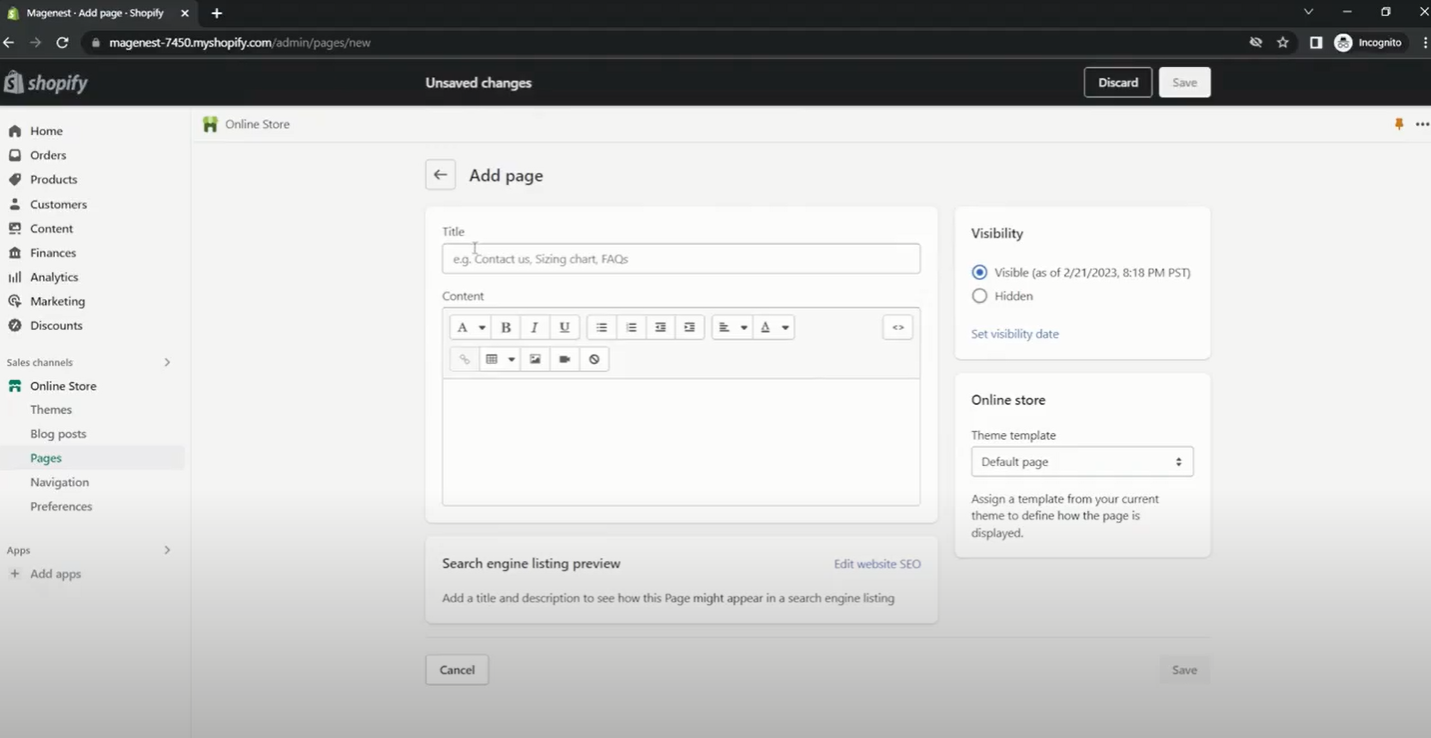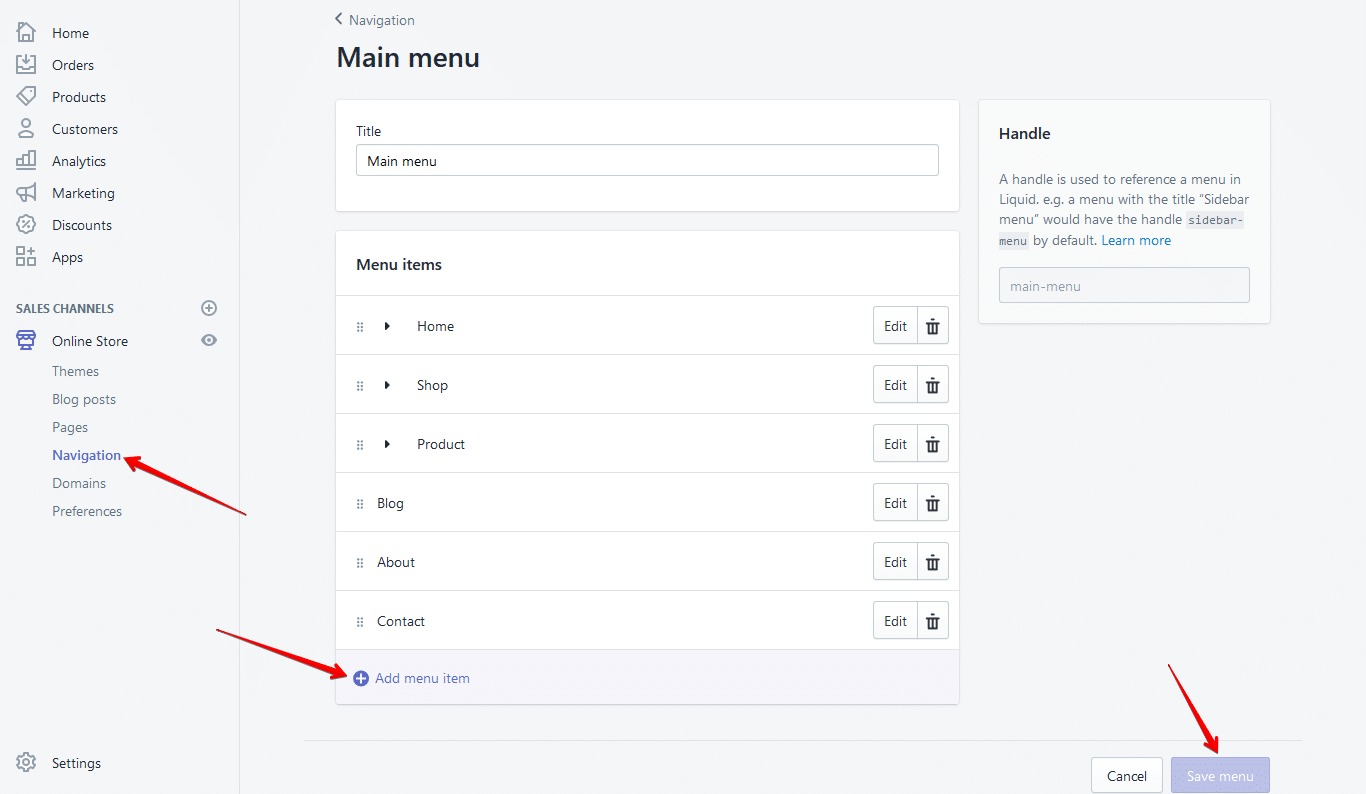As an online store owner, it’s important to have clear terms and conditions in place to protect your business and ensure a positive shopping experience for your customers. However, with so many legal requirements and technicalities involved, writing and adding terms and conditions to your Shopify store can be a daunting task. In this article, we guide you through the process of writing and adding terms and conditions for Shopify stores, step-by-step. From researching and identifying your unique policies to creating a new page and linking it to your store, we cover everything you need to know to make sure your terms and conditions are clear, comprehensive, and legally sound.
Table of Contents
- What Are The Terms and Conditions for Shopify stores?
- Why Does Your Shopify Store Need Terms And Conditions?
- How to Write Your Terms and Conditions for Shopify Store
- How to Add Your Terms & Conditions to Your Shopify Store
- Rare Beauty – Terms of Services Examples and Templates
- 3 Common Questions about Setting Terms & Conditions
What Are The Terms and Conditions for Shopify stores?
The Shopify store Terms and Conditions are a set of rules and guidelines that govern the use of your Shopify store by both you as the store owner and your customers. They are legally binding agreements that set out the terms under which you offer your products or services to your customers and outline the rights and responsibilities of both parties.
The Terms and Conditions cover various aspects of your store’s operation, such as payment and shipping policies, returns and refunds, product warranties, intellectual property rights, and limitations of liability.
In Shopify, you can create a dedicated page for your Terms and Conditions and link it to your store’s navigation menu, so it’s easily accessible to your customers. Having clear and comprehensive Terms and Conditions in place can help build trust with your customers and minimize the risk of disputes or legal issues down the line.
Why Does Your Shopify Store Need Terms And Conditions?
As a store owner, having well-crafted Shopify store terms of services that accurately reflect your business practices and protect your interests while complying with relevant laws and regulations is essential. It’s also important to ensure that your customers have access to your Terms and Conditions so that they can understand and agree to the terms before purchasing from your store.
- Legal Compliance: You are legally obligated to provide your customers with certain information and protect their rights under applicable laws and regulations. Having a clear and comprehensive set of Terms and Conditions helps you comply with these legal requirements and protect your business from potential legal disputes or liabilities.
- Setting Expectations: Your Terms and Conditions set out the rules and guidelines for how your store operates, including payment and shipping policies, returns and refunds, product warranties, and limitations of liability. By clearly stating these policies, you can set clear expectations for your customers and avoid misunderstandings or disputes.
- Protecting Your Business: Your Terms and Conditions can help protect your business by limiting your liability in case of disputes, defining your intellectual property rights, and preventing fraudulent or abusive behavior by customers.
- Building Trust: By providing your customers with transparent and comprehensive Terms and Conditions, you can help build trust with your customers and demonstrate your commitment to fair and ethical business practices.
How to Write Your Terms and Conditions for Shopify Store
Research and Review Other Stores’ Terms & Conditions
When writing the Terms of Service for Shopify stores, researching similar stores can help you create a comprehensive and effective agreement.

If you are confusing how to research similar stores and what aspects need to be considered, here are some tips that you should look for:
- Identify similar stores: Start by identifying stores that are similar to your own. Look for stores that sell similar products or services, target a similar audience, and operate in a similar way.
- Review their Terms and Conditions: Pay attention to the information and policies they include, such as payment and shipping policies, returns and refunds, warranties, and limitations of liability.
- Look for common practices: As you review the Terms and Conditions of similar stores, look for common practices that you can incorporate into your own agreement. For example, if many stores in your niche offer free shipping, you may want to consider including a similar policy in your own agreement.
- Identify gaps or areas for improvement: While reviewing other stores’ Terms and Conditions, identify any gaps or areas for improvement that you can address in your own agreement. For example, if you notice that many stores in your niche have unclear return policies, you may want to make sure that your own policy is clear and easy to understand.
- Tailor to your business: As you review other stores’ Terms and Conditions, keep in mind that your agreement should be tailored to your specific business needs. Make sure that you include policies and clauses that are relevant to your store and address any unique challenges or considerations.
- Get legal advice: While it’s not necessary to have a lawyer review your Terms and Conditions, it can be helpful to get legal advice to ensure that your agreement is legally sound and compliant with relevant laws and regulations.
Identifying Your Unique Policies And Requirements
When writing the Terms and Conditions for your Shopify store, it’s important to identify and address any unique policies and requirements that are specific to your business. To set your unique policies, you should:
- Consider your products or services: Start by considering the specific products or services that you offer. Are there any special instructions, restrictions, or requirements that customers should be aware of? For example, if you sell food products, you may need to include information about allergens and safe handling practices.

- Identify any warranties or guarantees: If you offer any warranties or guarantees for your products or services, make sure to include them in your Terms and Conditions. This can help protect your business and ensure that customers understand what they are entitled to.
- Determine your return and refund policy: Your return and refund policy is an important part of your Terms and Conditions. Consider how you will handle returns and refunds, and make sure to include all relevant details, such as timeframes, conditions, and procedures.
- Address any shipping and delivery policies: If you offer shipping or delivery for your products, make sure to include policies related to shipping times, delivery options, and tracking information.
- Include any privacy and data protection policies: If you collect any personal information from customers, it’s important to include a privacy policy in your Terms and Conditions. Make sure to address how you will collect, store, and use this information, and provide information on any data protection laws or regulations that apply.
- Cover any legal disclaimers or limitations of liability: Depending on the nature of your business, you may need to include legal disclaimers or limitations of liability in your Terms and Conditions. This can help protect your business from legal disputes and liability.
By identifying and addressing your unique policies and requirements, you can create comprehensive and effective Terms and Conditions for Shopify stores.
Be Specific and Comprehensive
When generating Terms and Conditions for Shopify stores, it’s crucial to be specific and comprehensive. Being specific means including all relevant details and information in your agreements. Being comprehensive means addressing all possible issues and situations that may arise and legal requirements that may apply to your business.

Here are some key points to keep in mind when it comes to being specific and comprehensive in your Terms and Conditions:
- Define key terms: In your agreement, clearly define any key terms that may be used throughout, such as customer, product, or refund. This ensures everyone understands the meaning of these terms and avoids any misunderstandings.
- Cover all aspects of the customer experience: Your agreement should cover all aspects of the customer experience, including ordering, payment, shipping, and returns. Be sure to outline your policies for each of these areas, including any restrictions or requirements.
- Address potential issues: Consider any potential issues that may arise in the course of doing business, such as delays in shipping, product defects, or customer complaints. Address these issues in your agreement to ensure that everyone is clear on how they will be handled.
- Be transparent: Your agreement should be transparent and clear, outlining your policies and procedures in a way that is easy to understand. Avoid using legalese or overly complicated language, and use bullet points or subheadings to break up the text.
- Update regularly: Your business may change over time, and your Terms and Conditions should reflect those changes. Regularly review and update your agreement to ensure that it remains accurate and up-to-date.
By defining key terms, covering all aspects of the customer experience, addressing potential issues, being transparent, complying with legal requirements, and updating regularly, you can create a clear and effective agreement that benefits both you and your customers.
Include All Relevant Information
Another factor you should consider when writing Terms and Conditions for Shopify store is to include all relevant information such as your policies, procedures, and any legal requirements that apply to your business. This ensures that your customers have a clear understanding of your policies and procedures.

Here are some key areas to consider when including relevant information in your agreement:
- Payment and Pricing: This includes information about accepted payment methods, any fees or charges that customers may be responsible for, and any applicable taxes.
- Shipping and Delivery: Make sure to include information about your shipping and delivery policies such as shipping rates, delivery times, and any restrictions or limitations that apply to certain products or locations.
- Returns and Refunds: Your policies regarding returns and refunds should cover information about how customers can initiate a return or refund, any time limitations or restrictions, and any conditions that must be met for a return or refund to be accepted.
- Privacy and Data Collection: Be sure to include a section on privacy and data collection. This includes information about how you collect and use customer data, any third-party service providers you use, and how you protect customer data.
- Intellectual Property: If you have any trademarks, copyrights, or other intellectual property associated with your business, make sure to include information about how these are protected and any restrictions on their use.
- Governing Law: Your agreement should include information about which laws govern the agreement. This includes information about the jurisdiction and any dispute resolution procedures that may apply.
Use the AI Content Generator Tool
There are many AI content generators such as Shopify’s free terms and conditions generator tool to create a basic agreement for your store. These tools allow you to select from a range of pre-written clauses and customize them to meet your needs and are useful for generating basic templates or providing suggestions.
However, it’s important to carefully review the generated agreement and make any necessary adjustments or additions to ensure it accurately reflects your business policies and procedures.
How to Add Your Terms & Conditions to Your Shopify Store
Adding the terms and conditions page to your Shopify store is a simple process that involves creating a new page and linking to it from your store’s navigation menu. Here are the steps to add the terms and conditions page to your Shopify store:
Creating a New Page
- Log in to your Shopify account and navigate to your store’s admin dashboard.
- Click on Online Store from the left-hand navigation menu.
- Select Pages from the dropdown menu.
- Click on the Add page button in the upper right-hand corner.
- Enter a title for your page, such as Terms & Conditions.
Copying And Pasting the Content
- Once you’ve created the page, go to your existing Terms & Conditions document.
- Select all of the text and copy it to your clipboard.
- Go back to your Shopify store and click into the content area of your new Terms & Conditions page.
- Paste the text from your clipboard into the content area.
Linking to The Page From Your Store
After you’ve created the page and added the content, you’ll need to link to it from your store’s navigation menu so customers can easily find and access it.
- From your Shopify admin dashboard, click on Online Store from the left-hand navigation menu.
- Select Navigation from the dropdown menu.
- Click on the Add menu item button in the footer of the page.
- Enter a name for your menu item, such as Terms & Conditions.
- In the Link field, enter the URL for your new Terms & Conditions page. This will usually be something like /pages/terms-and-conditions.
- Click Add to save the new menu item.
Making Sure It’s Visible And Accessible To Customers
Finally, make sure that your new Terms & Conditions page is visible and accessible to your customers.
- Go back to your Pages section and click on the Edit button next to your new Terms & Conditions page.
- In the Visibility section, make sure that Online Store is selected so that the page is visible on your store.
- Click Save to publish the changes.
By following these steps, you should now have a new Terms & Conditions page that is linked to your store’s navigation menu and visible to your customers. It’s important to periodically review and update your Terms & Conditions page as needed to ensure that it’s accurate and up-to-date with any changes to your store’s policies or legal requirements.
Rare Beauty – Terms of Services Examples and Templates
Rare Beauty is a makeup brand owned by the popular singer Selena Gomez. To make sure their products arrive in perfect condition for their beauty-loving customers, Rare Beauty has created a very detailed Terms of Services page. This page includes information on prices, delivery policies, returns, refunds, and more.
Payment and Pricing
Rare Beauty’s Payment and Pricing policies include detailed information about pricing and payment for a service. It specifies that taxes and shipping costs are added at checkout, and it highlights the need for accurate payment information. The mention of price changes without notice and the responsibility for unpaid balances is straightforward.
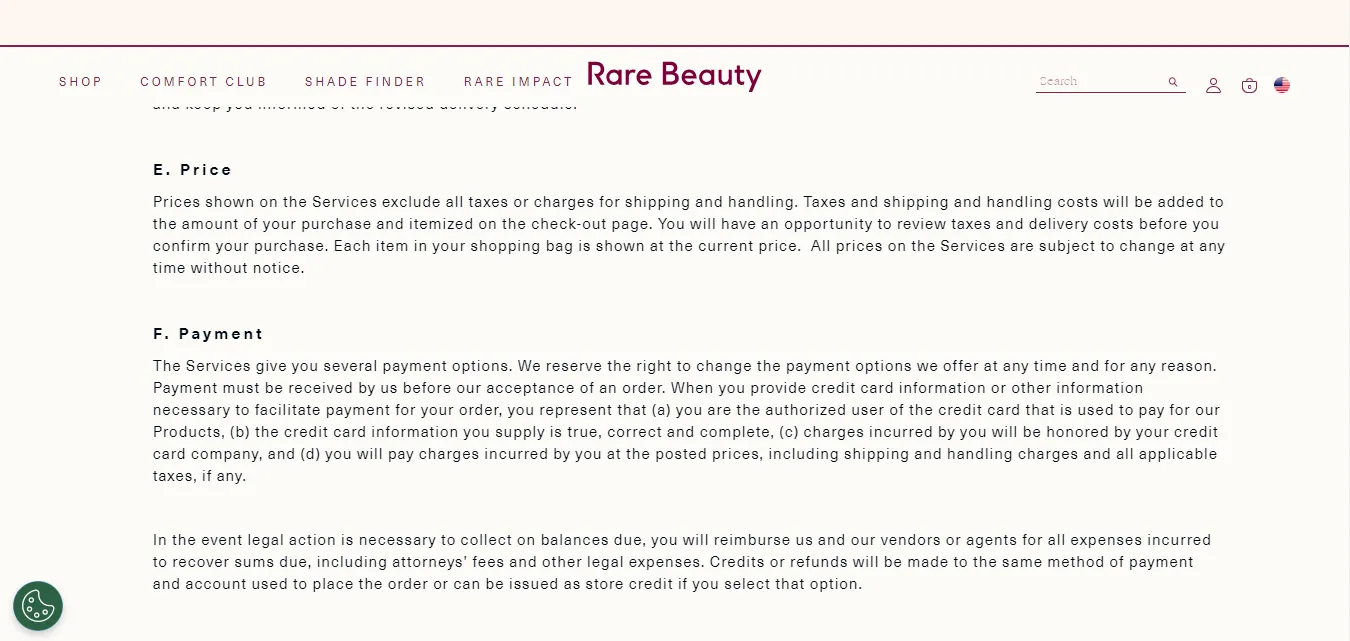
However, it could be simplified slightly for better readability by breaking down complex sentences and avoiding legal jargon, ensuring all customers can easily understand the policies. Try to simplify and make clear your policy terms as best as possible.
Shipping and Delivery
Rare Beauty’s Order process provides clear information about the order process and potential errors. It outlines the customer’s responsibility and the company’s right for shipping and handling the shipping process.
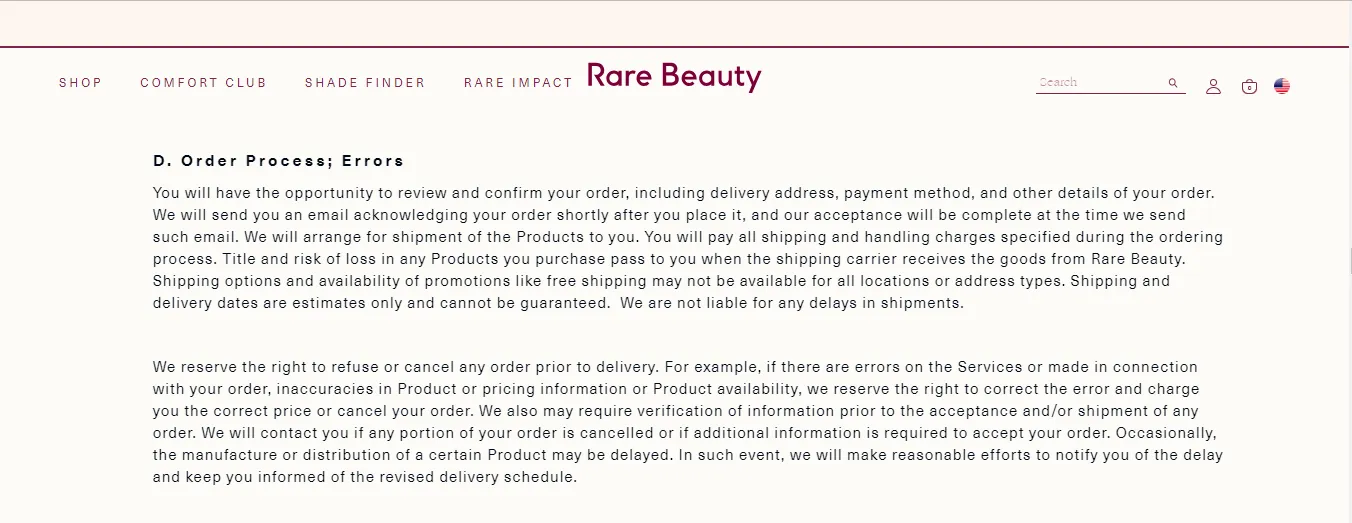
Additionally, the mention of potential delays in product manufacturing or distribution, along with the commitment to inform customers of revised schedules, adds to the transparency.
Returns and Refunds
The Return and Refund policy is clear and thorough, providing customers with detailed information on how to return products purchased through Rare Beauty’s services.
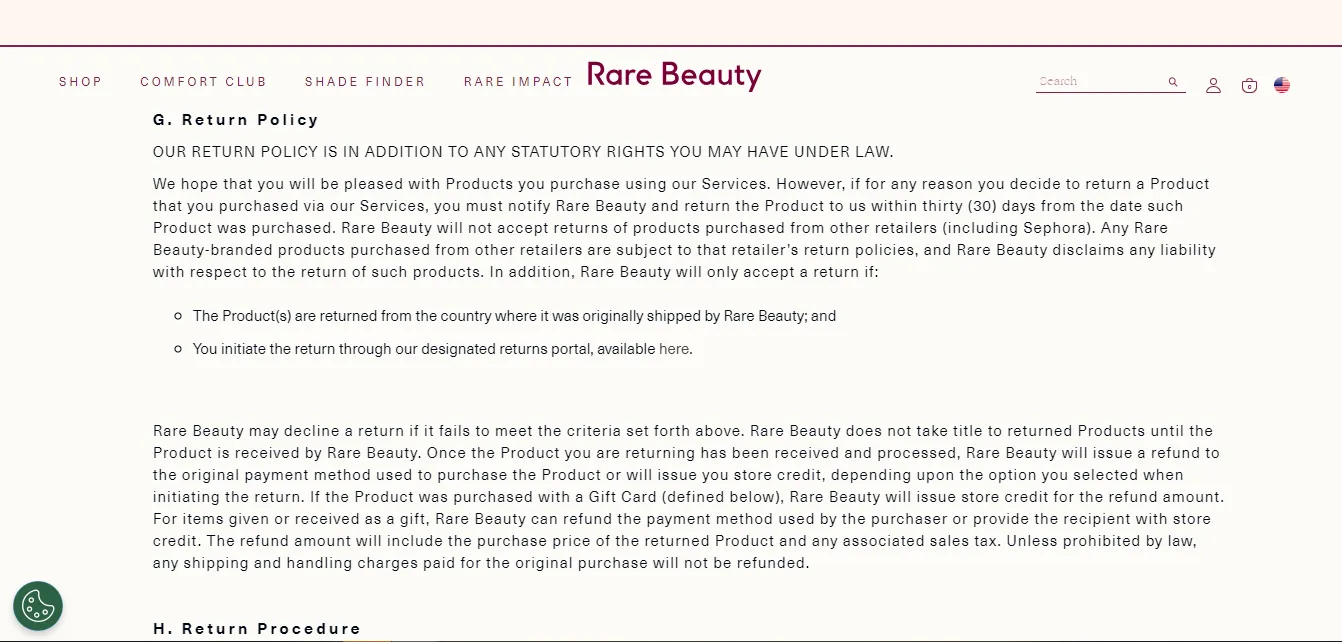
It emphasizes that this policy is in addition to any statutory rights, ensuring customers understand their legal protections.
Privacy Data and Collection
The privacy policy is comprehensive and detailed, clearly explaining how Rare Beauty collects, uses, and discloses personal information. It covers various aspects, including data collection methods (both direct and automatic), the use of personal data for services and marketing, and disclosure practices to third parties and vendors. The policy also outlines user rights and choices regarding data access, correction, deletion, and opting out of targeted advertising.

The sections on international customers, California residents, and specific legal obligations provide necessary legal compliance information. The policy’s clarity is enhanced by structured sections and subheadings, making it easy to navigate. However, the extensive legal and technical language might be overwhelming for some users. Simplifying certain sections could improve accessibility and readability for a broader audience.
Intellectual Property
The section on Ownership and Trademark is clear and well-structured. It establishes that all content within Rare Beauty’s services is owned by the company or its licensors and is protected by law. It effectively communicates that any unauthorized use of the services or trademark will result in the termination of the license and infringement of intellectual property rights.
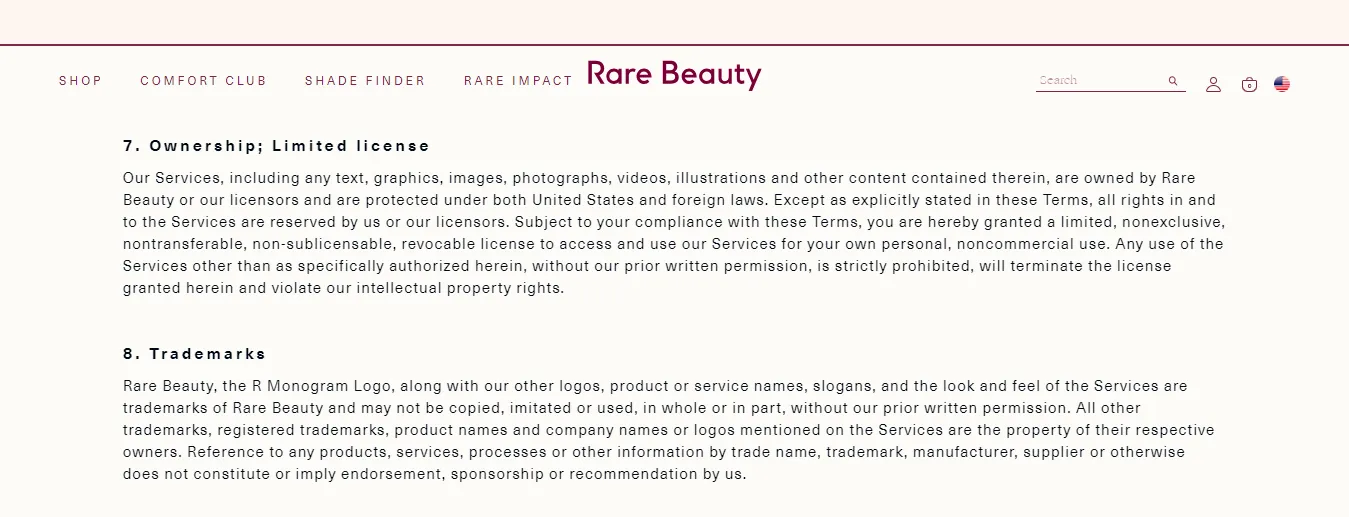
Overall, the language is precise and the terms are explicitly stated, making it easy for users to understand their rights and limitations regarding the use of Rare Beauty’s services and intellectual property.
Governing Laws
The Governing Law and Venue section is concise, effectively communicating the legal framework under which the Terms will be interpreted and enforced.

It states that California law governs, except where U.S. federal law applies and requires legal actions to be brought in Los Angeles courts, with users agreeing to their jurisdiction. An exception is included for local laws that require consumer contracts to be interpreted and enforced locally.
3 Common Questions about Setting Terms & Conditions
Do I really need Terms of Service for your Shopify store?
Answer: Yes. Terms & Conditions establish the rules and guidelines that customers must agree to when using your store. They help protect your business from legal disputes, set clear expectations for customers, and ensure compliance with applicable laws.
Do I need a lawyer to draft my Terms & Conditions?
Answer: While not strictly necessary, hiring a lawyer to draft your Terms & Conditions for your Shopify store is highly recommended. This professional touch mitigates risks, clearly defines rights and obligations, and provides robust protection for your business, ultimately saving time and potential legal costs.
How often should I update my Terms & Conditions?
Answer: You should review and update your Terms & Conditions at least annually to ensure they remain accurate and compliant with current laws and business practices. Additionally, update them whenever there are significant changes in your business operations, products, services, or applicable legal requirements.
Regular updates help protect your business from legal risks, ensure clarity for customers, and maintain compliance with evolving industry standards and regulations. Always notify customers of any changes to your T&C to maintain transparency and trust.
What legal requirements should I consider for international customers?
Answer: If you sell internationally, consider the legal requirements of the countries where your customers are located. Include information on international shipping, taxes, duties, and compliance with local laws.
Creating comprehensive and clear Terms & Conditions is crucial for protecting your Shopify store and ensuring a positive experience for your customers. If you need further assistance, consulting with a legal expert can provide additional guidance tailored to your business.
In conclusion,
Having clear and comprehensive terms and conditions in your Shopify store is crucial for protecting your business and ensuring a positive customer experience. By following the steps outlined in this article, you can create a set of terms and conditions for the Shopify store that reflect your unique policies and requirements, while also meeting legal requirements and industry standards. By adding the terms and conditions page to your store and making it easily accessible to customers, you can help build trust and credibility with your audience, while also avoiding potential disputes and legal issues down the line. With a solid set of terms and conditions in place, you can focus on growing your business and providing the best possible shopping experience for your customers.
If you are looking for merchants to develop a Shopify store for your business, see more information at our website development services. Our professional team helps you find a great eCommerce solution for growing your business.


